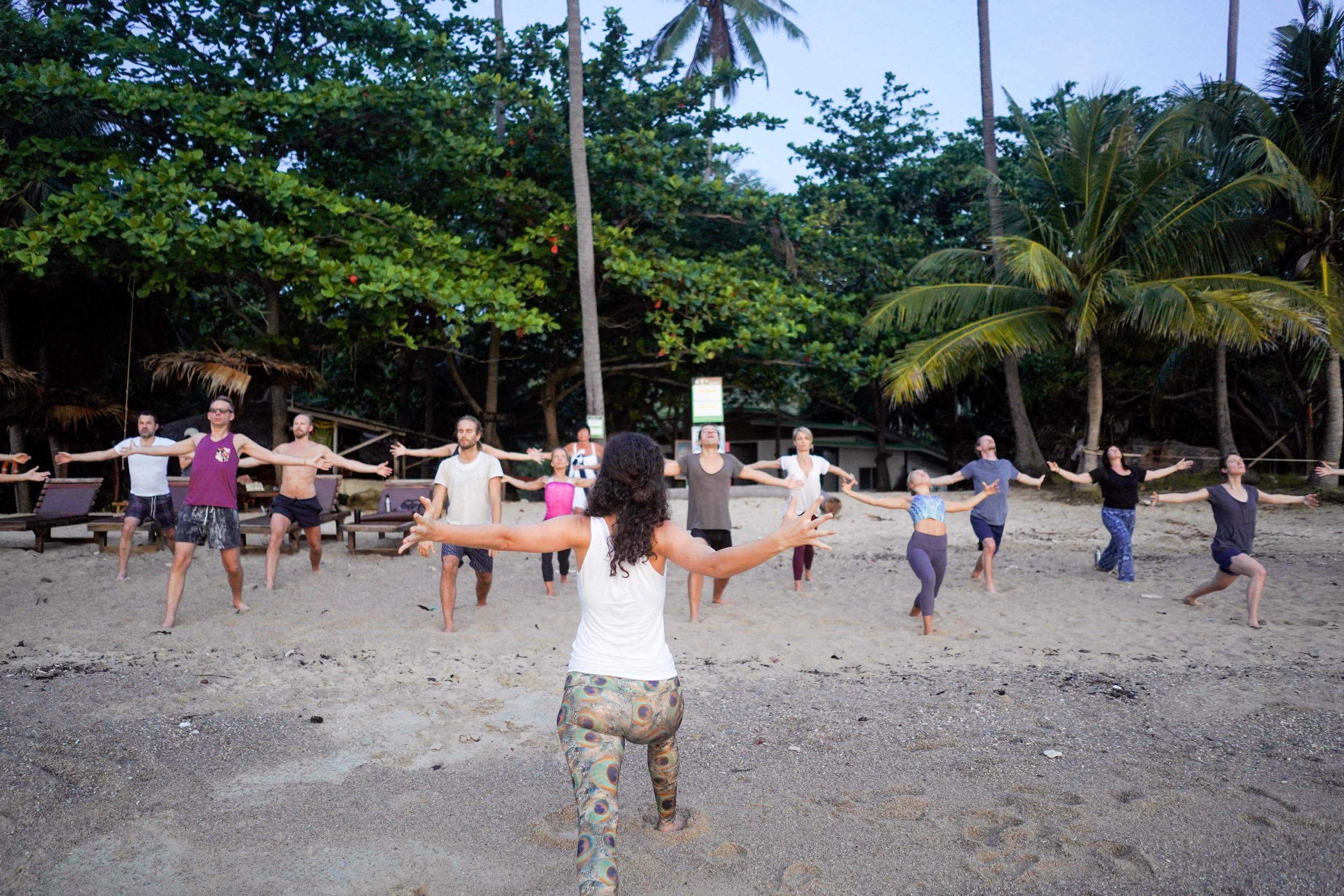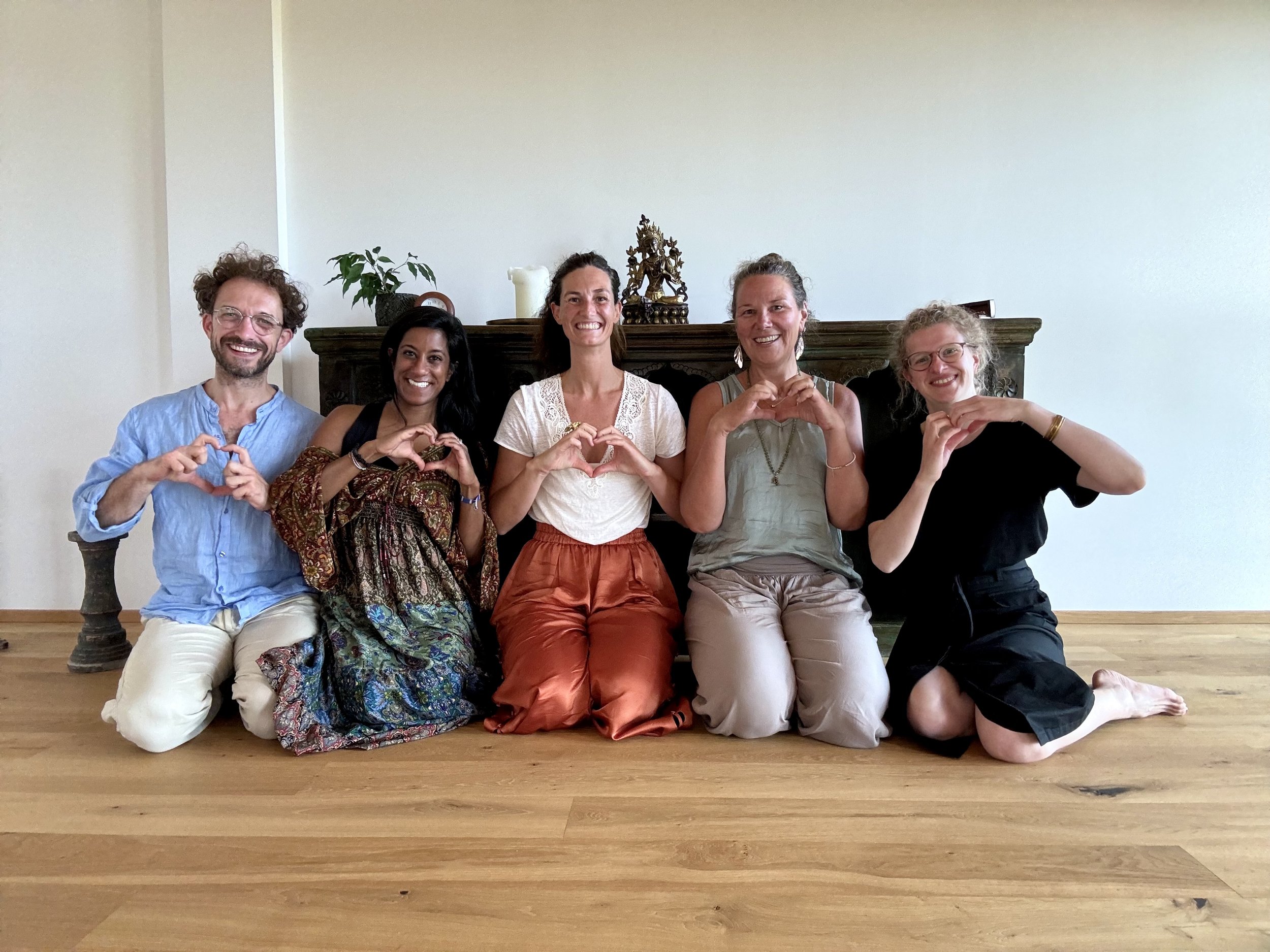
Shiva’s Dance of Love
I want to join with you, I want to open my heart to you without any expectations, give you all my love without any conditions, honour and respect this love, never do anything to harm this love, and to create this strength I need to be this loving.
Anahata Yoga
Anahata Yoga is a very rare and ancient tradition, which maintains the opening of the heart chakra as a connecting point between consciousness (Shiva) and Kundalini energy (Shakti) and represents love, compassion, clarity and balance.
In Anahata Yoga, it’s believed that the most important thing you’ll ever do in your life is to open your heart to yourself, to love yourself exactly the way you are, without any expectations and without any conditions, so that you can then love others exactly the way they are as well.
Anahata Yoga is about the exploration of yourself, about opening up your heart and to find out who you truly are and what your true potential is in this life.
This style of Yoga is suitable for everyone. There’s nothing to achieve, it’s about exploration, discovery, learning and growing in a gentle way.
A deeper dive into the
Philosophy of Anahata Yoga
Anahata Yoga is an ancient Yogic tradition that comes from Assam, in the Himalaya Mountains in North East India. It has its roots in Hatha Yoga. The meaning of Hatha Yoga is:
Ha = the sun
Tha = the moon
Yoga = the yoke, the joining
Combined those three words mean the joining of the sun and the moon.
The sun is the symbol for Shiva who represents the conscious awareness of the mind (male energy) that re-sides in Sahasrara Chakra, in the crown of the head. The moon is the symbol of Shakti who represents Kundalini Shakti energy (female energy) that resides in Muladhara Chakra, in the base of the body.
One of the intentions of Anahata Yoga is to join the consciousness of Shiva with the energy of Shakti, to make them dance and let them meet in a beautiful union in your heart.
In the Anahata Yoga tradition, this is known as the “Dance of Shiva and Shakti” - this dance is facilitating the movement of Shakti, the moon (the female energy) into the embrace of Shiva, the sun (the male energy). It’s believed that when they come together in this dance in a playful, harmonious and balanced way, they create the potential for unlimited creativity.
Now, if you’re reading this and are new to Yoga, then this might sound a little outer worldly right now. So, let me break it down a little:
We all have female and male energies in our bodies, often times, we do have a tendency to connect more to the feminine side of us or the other way around, more to the male side. By practicing Anahata Yoga, we connect those two energies and bring them into a more harmonious state again. Meaning: we bring ourselves into a more harmonious and balanced state.
Some male characteristics are: being focused, having a plan, being organized, going on adventure, showing up in the world, meeting people, being strong, having boundaries
Some female characteristics are: going with the flow, being soft, going inwards, reflecting, being by yourself, hybernating, showing your vulnerability
Now, maybe you know your own tendencies, where your strengths lie and what might be more difficult for you.
By practicing Anahata Yoga, we want to bring the male and the female energies together. Shiva and Shakti. The sun and the moon.
When we unite them, when we unite ourselves, life becomes more easy, graceful, playful and joyous. We’re freeing ourselves from our limited beliefs of what life should look like, of how life should be experienced and what we should be “achieving” in life.
There will be a lot more “being” in your life and not always “doing, doing, doing”.
Anahata Yoga = Heart Yoga
Anahata Yoga philosophy is the Yoga practice of opening your heart, to transcend the physical body and the mind’s limited consciousness and to love yourself exactly the way you are. This is what we call: Anandamaya Kosha. It’s said that this is one of the most important things to be achieved in your Yoga life: to allow your personal conscious development and evolution of divine spirit.
To choose to love yourself exactly as you are and be compassionate about the things that you would like to change, knowing that with the gift of free will you have the ability to choose to change and create whatever you can imagine.
The choosing to open the heart is a powerful personal mental image, a symbol for the mind that regards the heart as the centre of love, passion, courage, bravery, compassion. The mind then chooses thoughts that flow from the energy of the heart rather than from the judgment, comparison and criticism of the intellectual critical mind.
Anahata Yoga Practices
Asana
Asanas are the movements of the physical body in Yoga. In Anahata Yoga, the Asanas have the roots in classical Hatha Yoga but we move in a gentle Vinyasa Flow instead of holding the poses. The Asana classes are also infused with movements of the 5 Element Form (part of the Anahata Yoga tradition).
Asanas are often the first contact point that people have with Yoga. Connecting to the body through these movements, moving with intention into different poses, stretching, opening but also strengthening it, can be a great support in every day life.
For example: By stretching the body, we help the body to let release and let go. It will help you to let go and release more easily in every day life as well (emotions, feelings, disagreements with loved ones).
By opening the body, you become more open towards life.
Over time, when the body becomes more flexible, you’ll also become more flexible in every day life. Moving around the obstacles and challenges in life like water instead of feeling stuck.
By strengthening the body, you’re also strengthening the mind and become stronger in every day life.
Pranayama (breath exercises)
Since ancient times, breath has been considered inseparable from life, health, consciousness, and spirit. The breath was considered, by ancient people in India, to be a force that ran through the mind, body, and spirit like a river flowing through a dry valley giving sustenance to everything in its course.
Prana means “life force” in Sanskrit and describes the energy that is believed to sustain the life of the body.
Ayama translates into "expand, extend or draw out”.
Although some say that the word is actually derived from
Yama, which means “control”.
In today’s times, many people are not aware of the way they’re breathing and how the quality of the breath can have a big impact on the quality of their life.
We breathe in habitual ways and patterns, without being aware of it. We hold our breath when someone is telling a story, or when we are very focused on our work at our screens. Every time we do that, it has a negative effect on the function of our bodies.
But we can start bringing more awareness into the way we’re breathing and learn how different techniques can help us to calm down, to go into a deep relaxed state, to become more focused and sharpen our minds, or to use an active breath when we move our bodies.
Meditation
Is derived from two Latin words:
Meditani which means “to think, to dwell on, to exercise the mind”
Mederi which translates to “to heal”.
Its Sanskrit derivation
Medha means "wisdom".
Simplistically, meditation is the method of bringing a scattered, disorganized mind into a state of peace, quiet, calm and tranquillity.
Meditation begins as a technique but eventually becomes a state of life where the mind is freed from scattered thoughts, external distractions and the reactions and patterns of behaviour that result from this.
The mind of a meditator becomes the consciously aware observer during meditation, not the commander, the judge, the comparer, the criticizer, or the fixer.
This creates freedom from constant negative thoughts.
Merely observing allows the mind’s perception to change, which changes everything that is perceived outside the mind.
In the Anahata Yoga Philosophy, there’s very beautiful meditations like the “Beggar’s Bowl Meditation”, a wonderful meditation to start your day with creating an attitude of gratitude for life. Looking at the things that you’ve in your life rather than the things that you don’t have.
The “Heart Opening Meditation”, which focuses on opening your heart to yourself and let the beautiful, healing energy of the heart flow into your body and mind.
Then, the “Akasha Meditation”, a meditation to connect to a higher consciousness than your own.
Yoga Nidra
Yoga Nidra is the Yogic sleep which is a technique where the body and mind are very relaxed and open for suggestions.
During this deep resting practice, where you travel into theta brain waves and sometimes even delta brainwaves, you can start to re-program and re-wire your mind, also known as NLP (Neuro linguistic programming).
The way that this is done is by planting positive seeds, in Yoga known as Sankalpas (translates to “resolve”) within the subconscious mind. It’s a very powerful affirmation tool where a mental statement is impressed on the subconscious mind while it is receptive and sensitive to autosuggestions. It’s a form of self-hypnosis that can create a lasting change.
Yoga Nidra is an opportunity to replace negative Samskaras (habitual patterns of behaviour that are reactions to personal belief systems) that do not enhance the quality of your life with more positive creative Samskaras.
Samskaras (negative and positive ones) are stored within the layers of your inner consciousness:
the deeper unconscious layers where they are latent but not consciously manifested
the mid subconscious layer where they are in the process of transition and manifestation
and the upper layer of consciousness where they mature and create.
Mantra
Mantra Yoga is the basis of many Yoga healing techniques using sound energy.
The various forms of energy that exist in the universe are sound, light, heat and movement. This means that the universe manifests and exists simultaneously on several levels (dimensions).
The universe exists on a gross level as matter, on another as light, on another as sound and all these levels of energy can be used for healing.
Mantra Sadhana is considered with the liberation and power of sound to heal and raise one’s consciousness.
The Origin of Mantra
The conscious mind represents only a minuscule portion of our mental capacity, even if it is controlled, the subconscious and unconscious minds continue with their own patterns of thought, reactions, actions without any control.
Yogis realized that a method of control was needed that had an effect on the totality of the mind and one system they devised was the science of Mantra.
The literal meaning of Mantra is “the force that enables the energy, which is in the form of the mind to become free”.
Modern science knows that everything in the universe is in a state of vibration and resonates at its own unique frequency. The earth disturbs and compresses the surrounding air creating sound which is only audible if the frequency is within our hearing range. Creation was the origin of sound and we are continuously surrounded by it.
What are Mantras
Mantras are powerful sounds that when chanted produce powerful effects. When Mantras are chanted repeatedly it’s called Japa.
Mantras are very rich in their meaning, so while doing Japa, one can meditate on the Mantra and its meaning.
As the mind dwells more and more into that meaning, the Mantra conditions the mind and takes it up to higher states and forms the path to the great liberation of eternal bliss.
What makes Mantras so special as compared to the normal words and sounds that we know, is that it’s believed that Mantras were not composed by humans.
One may wonder how can that be possible, especially given that there are ancient sages associated with the Mantras?
It is believed that these ancient sages are not the composers of these Mantras as we would normally compose sentences, they are not the inventors, but they are the discoverers of the Mantras.
They channeled and got to understand the meaning of the Mantras while they were in a deep state of meditation.









